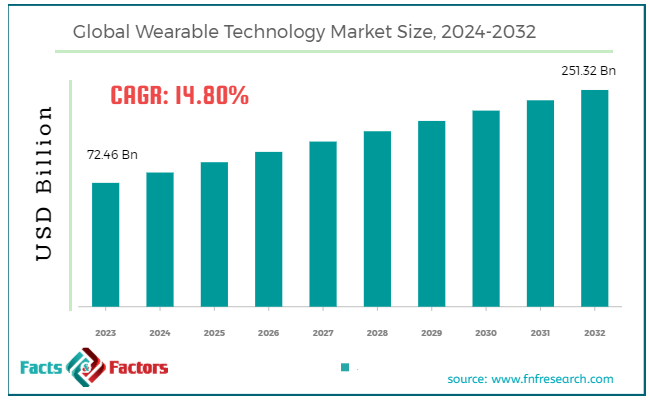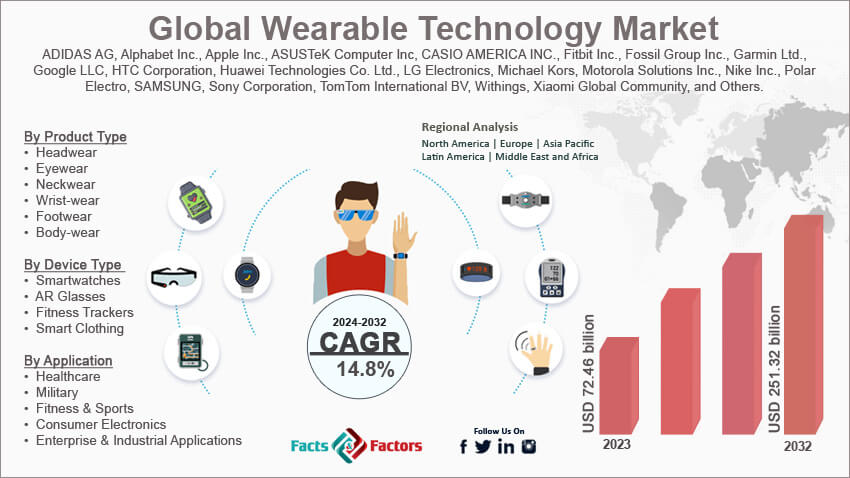Search Market Research Report
Wearable Technology Market Size, Share Global Analysis Report, 2024 – 2032

Wearable Technology Market Size, Share, Growth Analysis Report By Product Type (Headwear, Eyewear, Neckwear, Wrist-wear, Footwear, Body-wear, and Others), By Device Type (Smartwatches, AR Glasses, Fitness Trackers, Smart Clothing, and Others), By Application (Healthcare, Military, Fitness & Sports, Consumer Electronics, Enterprise & Industrial Applications, and Others), and By Region - Global Industry Insights, Overview, Comprehensive Analysis, Trends, Statistical Research, Market Intelligence, Historical Data and Forecast 2024 – 2032
Industry Insights
[213+ Pages Report] According to Facts & Factors, the global wearable technology market size in terms of revenue was valued at around USD 72.46 billion in 2023 and is expected to reach a value of USD 251.32 billion by 2032, growing at a CAGR of roughly 14.8% from 2024 to 2032. The global wearable technology market is projected to grow at a significant growth rate due to several driving factors.

 Market Overview
Market Overview
Wearable technology refers to electronic devices designed to be worn on the body, either as accessories or embedded in clothing and textiles. These devices often incorporate sensors, software, and connectivity features to collect and exchange data with other devices or networks. Wearable technology includes a wide range of products such as smartwatches, fitness trackers, smart glasses, and even smart clothing, all aimed at enhancing the user’s lifestyle, health, and productivity.
The wearable technology market has witnessed significant growth over the past decade, driven by advancements in technology, increasing health awareness, and the rising popularity of connected devices. The market includes various segments such as fitness and health monitoring devices, smartwatches, augmented reality (AR) glasses, and wearable cameras.
 Key Highlights
Key Highlights
- The wearable technology market has registered a CAGR of 14.8% during the forecast period.
- In terms of revenue, the global wearable technology market was estimated at roughly USD 72.46 billion in 2023 and is predicted to attain a value of USD 251.32 billion by 2032.
- The wearable technology market is poised for substantial growth, driven by technological advancements, increasing health awareness, and the rising popularity of multifunctional devices like smartwatches and fitness trackers.
- On the basis of product type, the wrist-wear segment is growing at a high rate and is projected to dominate the global market.
- Based on the device type, the smartwatch segment is projected to swipe the largest market share.
- In terms of application, the consumer electronics segment is expected to dominate the global market.
- By region, North America dominates the wearable technology market due to high consumer disposable income, technological innovation, and the strong presence of key market players.

 Growth Drivers:
Growth Drivers:
- Health & Wellness Revolution: People are becoming increasingly health-conscious, driving demand for wearables that track a vast array of health metrics. These devices monitor everything from daily steps and sleep patterns to heart rate, blood oxygen levels, and even stress. This empowers individuals to take a proactive approach to their well-being.
- Technological Advancements: Continuous innovation in miniaturization, battery life, sensor technology, and connectivity fuels new functionalities and broader appeal.
- Smartwatch Boom: Smartwatches are leading the wearables market, offering a blend of fitness tracking, communication features, and mobile payment options.
- Integration with Smartphones: Seamless integration with smartphones allows for data analysis, personalized recommendations, and broader application support.
- Growing Fashion Focus: Fashionable and stylish wearables are emerging, blurring the lines between technology and personal style, attracting a wider audience.
 Restraints:
Restraints:
- Privacy Concerns: Data privacy and security issues regarding personal health information collected by wearables can deter some users.
- Battery Life Limitations: Limited battery life can be a major pain point for users, requiring frequent charging and potentially interrupting functionality.
- High Device Costs: High initial costs of some wearables can be a barrier to entry for budget-conscious consumers.
- Limited Functionality of Basic Wearables: Simpler wearables may lack features that entice users to upgrade from traditional alternatives (e.g., basic watches).
 Opportunities:
Opportunities:
- Expansion into Healthcare: Integration with healthcare platforms and medical applications opens doors for disease management, remote monitoring, and personalized treatment plans.
- Focus on Mental Wellbeing: Wearables with stress monitoring and mindfulness features cater to the growing demand for mental health support.
- Emerging Markets: Developing economies with increasing smartphone penetration present a vast opportunity for affordable wearable technology.
- Enterprise Applications: Wearables can offer workforce management solutions, safety monitoring, and improved productivity in various industries.
 Challenges:
Challenges:
- Standardization Issues: Lack of industry-wide standards for data collection and interoperability can create compatibility challenges between devices and platforms.
- Security Vulnerabilities: Security vulnerabilities in wearables can expose user data to hacking and breaches.
- Short Product Life Cycles: Rapid technological advancements can lead to short product life cycles, pressuring users to upgrade frequently.
- Limited Consumer Awareness: Raising awareness about the full potential and benefits of wearables is crucial for broader market adoption.
 Wearable Technology Market: Segmentation Analysis
Wearable Technology Market: Segmentation Analysis
The global wearable technology market is segmented based on product type, device type, application, and region.
 By Product Type Insights
By Product Type Insights
Based on Product Type, the global wearable technology market is divided into headwear, eyewear, neckwear, wrist-wear, footwear, body-wear, and others. Headwear in the wearable technology market includes devices such as smart helmets, head-mounted displays, and augmented reality (AR) and virtual reality (VR) headsets. The headwear segment is driven by the increasing demand for AR and VR applications in gaming and entertainment, as well as their growing use in industrial and medical fields.
The eyewear segment is driven by the increasing adoption of smart glasses in professional and personal settings. Applications such as real-time data access, navigation, and health monitoring are significant growth drivers. Companies like Google, Vuzix, and North are leading the market with innovative products.
The neckwear segment is gaining traction due to the increasing focus on health and fitness. Features like heart rate monitoring, step counting, and sleep tracking are popular among consumers. Additionally, the integration of smart features with fashionable designs makes these devices appealing.
The wrist-wear segment is expected to continue its dominance with a robust CAGR of 48.2%, driven by continuous advancements in health monitoring technologies, increasing consumer health awareness, and the integration of more features in smartwatches and fitness bands?. Wrist-wear encompasses smartwatches, fitness bands, and health monitors worn on the wrist. These devices offer a range of functionalities, including timekeeping, fitness tracking, health monitoring, and smartphone connectivity.
The footwear segment is expected to grow steadily, supported by advancements in sensor technology, increasing consumer interest in fitness tracking, and the development of smart shoes with enhanced functionalities. The growing focus on health and fitness will continue to drive demand in this segment.
The body-wear segment is driven by innovations in smart textiles, increasing consumer demand for multifunctional clothing, and the rising focus on health and wellness. The development of more comfortable and stylish smart clothing will further boost market growth?.
 By Device Type Insights
By Device Type Insights
On the basis of Device Type, the global wearable technology market is bifurcated into smartwatches, AR glasses, fitness trackers, smart clothing, and others. Smartwatches are multifunctional wearable devices that provide timekeeping along with various other features such as fitness tracking, health monitoring, notifications, and connectivity to smartphones. The smartwatch segment is the largest and most mature market within wearable technology. The demand for smartwatches is driven by their multifunctionality, convenience, and the increasing consumer interest in health and fitness tracking. Major players like Apple, Samsung, Fitbit, and Garmin dominate this segment. The integration of advanced health monitoring features, such as ECG, blood oxygen monitoring, and sleep tracking, further enhances the appeal of smartwatches.
The AR glasses segment is driven by the increasing adoption of augmented reality in both consumer and enterprise applications. The demand for AR glasses is growing in sectors such as manufacturing, logistics, healthcare, and gaming, where they offer significant benefits in terms of productivity, training, and user experience. Companies like Google, Microsoft, and Vuzix are leading the market with their innovative AR glass products. The AR glasses market is expected to grow at a significant CAGR, fueled by advancements in AR technology, increasing investments in AR applications, and expanding use cases across various industries.
The fitness tracker segment is driven by the growing emphasis on health and fitness, rising awareness of lifestyle diseases, and the increasing adoption of wearable health monitoring devices. Fitness trackers are widely used for personal health management and are often integrated with health apps and services. Key players in this market include Fitbit, Garmin, Xiaomi, and Huawei.
Smart clothing, also known as e-textiles, integrates electronic components such as sensors, batteries, and communication devices into the fabric. The smart clothing segment is driven by the increasing demand for multifunctional and wearable health monitoring solutions. Smart clothing offers advanced features such as heart rate monitoring, muscle activity tracking, and temperature regulation, making them popular in sports, healthcare, and military applications.
 By Application Insights
By Application Insights
Based on Application, the global wearable technology market is categorized into healthcare, military, fitness & sports, consumer electronics, enterprise & industrial applications, and others. The healthcare segment is driven by the increasing prevalence of chronic diseases, the aging population, and the rising demand for remote patient monitoring. Wearable devices in healthcare provide continuous monitoring of vital signs, enabling early detection of health issues and reducing hospital visits.
The military segment is driven by the need for enhanced operational efficiency, soldier safety, and improved decision-making capabilities. Wearable devices provide real-time data on soldier health, location, and environmental conditions, enabling better command and control. The adoption of AR glasses for training and mission planning is also increasing.
The fitness and sports segment is driven by the growing awareness of health and fitness, the increasing popularity of fitness tracking devices, and the rising participation in sports and physical activities. Wearable devices provide insights into physical performance, helping users set and achieve fitness goals. Companies like Fitbit, Garmin, and Nike are leading this segment with innovative products.
The consumer electronics segment accounted for 49.3% of revenue share in 2023. This segment is driven by the increasing adoption of smart devices, the growing trend of connected living, and the demand for convenience and entertainment. The integration of smart features like voice assistants, notifications, and connectivity with other smart devices enhances the user experience. Major players like Apple, Samsung, and Google dominate this segment with their innovative wearable products.
The enterprise and industrial wearable technology market is expected to grow at a significant CAGR, supported by the increasing adoption of wearable devices in various industries, advancements in wearable technology, and the need for enhanced productivity and safety. The segment's growth is further fueled by the integration of IoT and AI technologies in wearable devices.
 Recent Developments:
Recent Developments:
- March 2022: March saw the launch of their latest Xiaomi Watch S1 Series. This smartwatch boasts a whopping 117 fitness modes, tracks health metrics like blood oxygen and sleep, and features convenient magnetic charging. It even integrates Amazon's Alexa voice assistant for added functionality.
- August 2022: Fitbit announced their new lineup in August, featuring the Sense 2, Inspire 2, and Versa 4. While specific details about these new Fitbits weren't mentioned, it highlights their continued presence in the wearables market.
 Report Scope
Report Scope
Report Attribute |
Details |
Market Size in 2023 |
USD 72.46 Billion |
Projected Market Size in 2032 |
USD 251.32 Billion |
CAGR Growth Rate |
14.8% CAGR |
Base Year |
2023 |
Forecast Years |
2024-2032 |
Key Market Players |
ADIDAS AG, Alphabet Inc., Apple Inc., ASUSTeK Computer Inc, CASIO AMERICA INC., Fitbit Inc., Fossil Group Inc., Garmin Ltd., Google LLC, HTC Corporation, Huawei Technologies Co. Ltd., LG Electronics, Michael Kors, Motorola Solutions Inc., Nike Inc., Polar Electro, SAMSUNG, Sony Corporation, TomTom International BV, Withings, Xiaomi Global Community, and Others. |
Key Segment |
By Product Type, By Device Type, By Application, and By Region |
Major Regions Covered |
North America, Europe, Asia Pacific, Latin America, and the Middle East &, Africa |
Purchase Options |
Request customized purchase options to meet your research needs. Explore purchase options |
 Wearable Technology Market: Regional Analysis
Wearable Technology Market: Regional Analysis
North America leads the market, accounting for approximately 34.6% of the global revenue in 2023. This dominance is attributed to the high rate of technology adoption, a large number of prominent market players, and robust healthcare infrastructure. The United States, in particular, is a major contributor due to its high consumer spending on health and fitness gadgets and the widespread acceptance of wearable tech in daily life. The region is projected to maintain strong growth from 2024 to 2032, fueled by high disposable income, significant presence of key market players like Apple and Fitbit, and increasing health awareness among consumers?.
In Europe, the wearable technology market is also significant, driven by high consumer awareness and the adoption of wearable devices for fitness, healthcare, and lifestyle enhancement. Key countries such as the UK, Germany, and France lead the market due to strong technological infrastructure and high consumer interest in advanced wearable gadgets. Europe's market is expected to grow at a steady CAGR during the forecast period, supported by a strong cultural inclination towards fitness and health monitoring, government initiatives promoting health tech adoption, and the presence of leading wearable technology companies?.
The Asia-Pacific region is anticipated to witness the fastest growth in the wearable technology market. This rapid growth is driven by increasing smartphone penetration, rising disposable incomes, and growing health awareness among consumers. China, Japan, and India are key markets within this region, with China leading due to its large population and technological advancements. The growth in this region is also supported by the increasing number of local manufacturers offering competitively priced products?.
Latin America is emerging as a significant market for wearable technology, driven by the growing middle class and increasing health awareness. Brazil and Mexico are leading markets in the region, supported by the adoption of fitness and health monitoring devices. The market is expected to grow steadily with a focus on expanding healthcare applications and fitness tracking, bolstered by rising consumer spending on technology and increasing presence of global wearable technology brands??.
The Middle East & Africa region is gradually expanding its wearable technology market, driven by the adoption of health and fitness devices and increasing technological advancements. The UAE and South Africa are key markets within this region, with growth supported by rising health awareness and the introduction of innovative wearable products. The region is projected to grow at a steady pace, driven by investments in healthcare infrastructure and technology adoption
 Wearable Technology Market: Competitive Landscape
Wearable Technology Market: Competitive Landscape
The analysis-intensive report provides key insights into companies and organizations operating in the global wearable technology market. The study further makes a relative examination of the organizations highlighting essential business parameters such as geographic presence, business overviews, product offerings, segment-based market share, operational strategies, and SWOT analysis. Recent enterprise developments including novel product launches, joint ventures, partnerships, strategic alliances, mergers & acquisitions, and product development are elaborated upon in the report. The in-depth study thus facilitates a comprehensive analysis of market competition.
Some of the main competitors dominating the global wearable technology market include;
- ADIDAS AG
- Alphabet Inc.
- Apple Inc.
- ASUSTeK Computer Inc
- CASIO AMERICA INC.
- Fitbit Inc.
- Fossil Group Inc.
- Garmin Ltd.
- Google LLC
- HTC Corporation
- Huawei Technologies Co. Ltd.
- LG Electronics
- Michael Kors
- Motorola Solutions Inc.
- Nike Inc.
- Polar Electro
- SAMSUNG
- Sony Corporation
- TomTom International BV
- Withings
- Xiaomi Global Community
The global wearable technology market is segmented as follows:
 By Product Type Segment Analysis
By Product Type Segment Analysis
- Headwear
- Eyewear
- Neckwear
- Wrist-wear
- Footwear
- Body-wear
- Others
 By Device Type Segment Analysis
By Device Type Segment Analysis
- Smartwatches
- AR Glasses
- Fitness Trackers
- Smart Clothing
- Others
 By Application Segment Analysis
By Application Segment Analysis
- Healthcare
- Military
- Fitness & Sports
- Consumer Electronics
- Enterprise & Industrial Applications
- Others
 By Regional Segment Analysis
By Regional Segment Analysis
- North America
- The U.S.
- Canada
- Mexico
- Europe
- France
- The UK
- Spain
- Germany
- Italy
- Rest of Europe
- Asia Pacific
- China
- Japan
- India
- Australia
- Southeast Asia
- Rest of Asia Pacific
- The Middle East & Africa
- Saudi Arabia
- UAE
- Egypt
- Kuwait
- South Africa
- Rest of the Middle East & Africa
- Latin America
- Brazil
- Argentina
- Rest of Latin America
Industry Major Market Players
- ADIDAS AG
- Alphabet Inc.
- Apple Inc.
- ASUSTeK Computer Inc
- CASIO AMERICA INC.
- Fitbit Inc.
- Fossil Group Inc.
- Garmin Ltd.
- Google LLC
- HTC Corporation
- Huawei Technologies Co. Ltd.
- LG Electronics
- Michael Kors
- Motorola Solutions Inc.
- Nike Inc.
- Polar Electro
- SAMSUNG
- Sony Corporation
- TomTom International BV
- Withings
- Xiaomi Global Community
Frequently Asked Questions

Copyright © 2024 - 2025, All Rights Reserved, Facts and Factors


